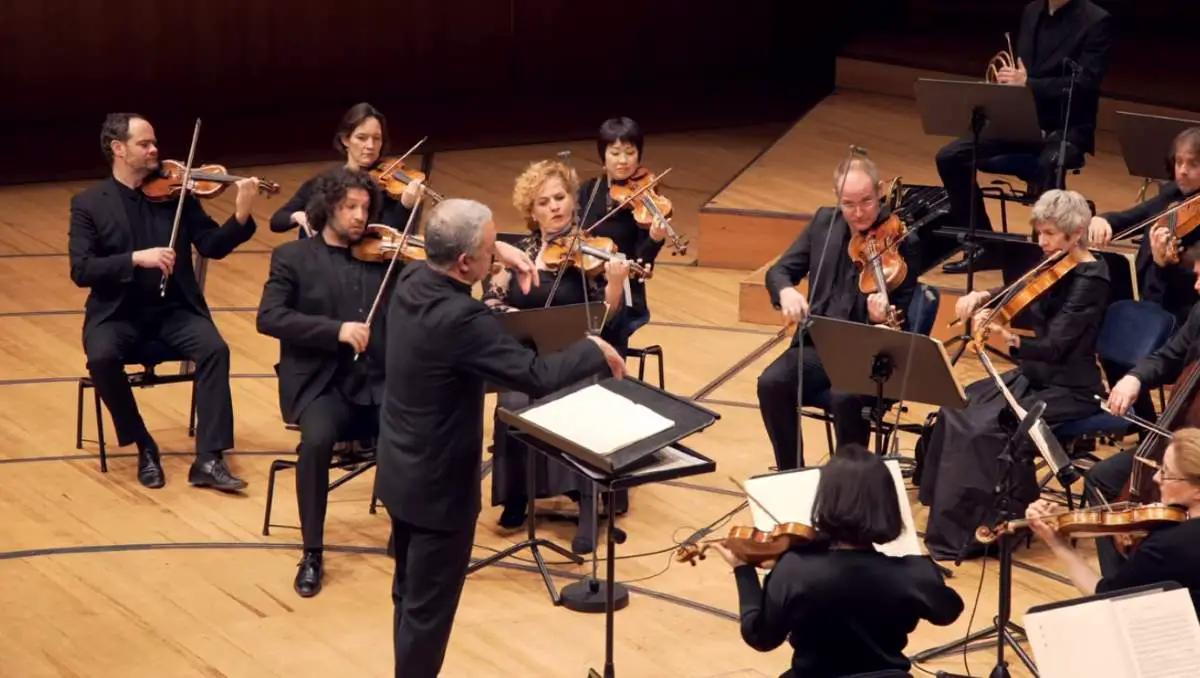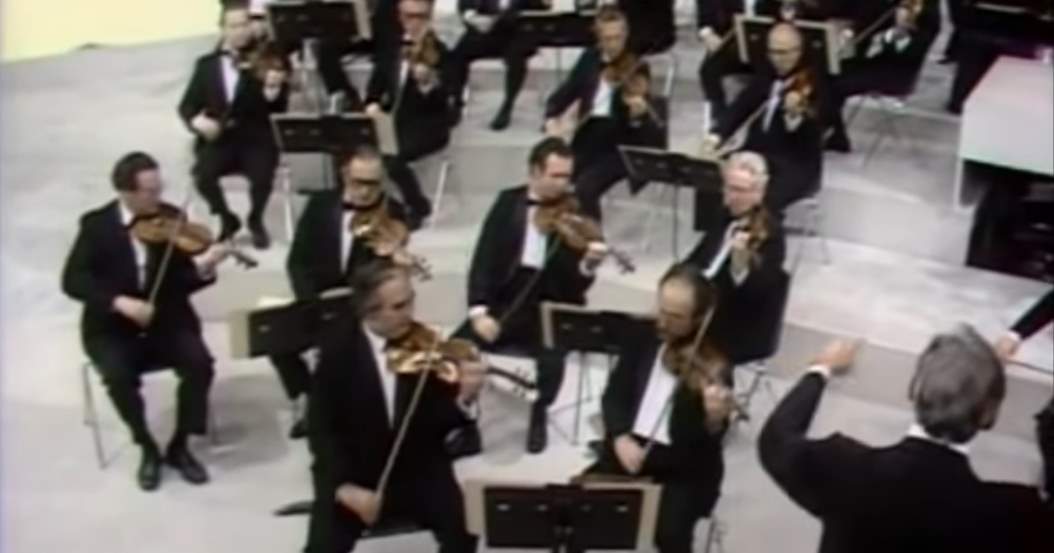Conducted by Andrés Orozco-Estrada, the hr-Sinfonieorchester (Frankfurt Radio Symphony Orchestra) performs Wolfgang Amadeus Mozart’s Symphony No. 40 in G minor, KV. 550. Recorded during the season-opening concert at Alte Oper Frankfurt on September 10, 2020.
Wolfgang Amadeus Mozart’s Symphony No. 40
Mozart’s Symphony No. 40 in G minor, K. 550, is one of his most famous and frequently performed works, often regarded as a pinnacle of classical music. Composed in the extraordinarily creative summer of 1788 (his last three symphonies, Symphony No. 39, 40, and 41 came out that summer), during a period of personal and financial turmoil for Mozart, this symphony stands out for its emotional depth and intensity. Unlike many of his other symphonies, which are often bright and cheerful, Symphony No. 40 is infused with a sense of urgency and melancholy, largely due to its minor key.
This symphony is one of only two that Mozart composed in a minor key, giving it a distinctive character. The use of G minor, a key often associated with sorrow and drama in the Classical period, underscores the work’s emotional weight. Throughout the symphony, Mozart masterfully combines lyrical beauty with dramatic tension, creating a work that is both captivating and profound.
The orchestration of Symphony No. 40 is notable for its clarity and transparency. Mozart employs a classical orchestra, with strings, woodwinds, and horns, but omits trumpets and timpani, which were often used to add brightness and grandeur. This choice contributes to the symphony’s darker, more intimate sound. The woodwinds, particularly the clarinets, which Mozart added in a later revision, play a prominent role in adding color and depth to the music.
The symphony is also marked by its motivic development, where Mozart takes small, simple musical ideas and transforms them into complex, evolving structures. This technique creates a sense of cohesion and unity throughout the work, as themes are developed and varied in innovative ways. The harmonic language is rich and varied, with frequent modulations and chromaticism adding to the symphony’s overall sense of tension and resolution.
Mozart’s Symphony No. 40 is sometimes referred to as the “Great G minor Symphony,” to distinguish it from the “Little G minor Symphony,” No. 25. These two pieces are the only extant minor key symphonies Mozart wrote.
The work is scored for flute, 2 oboes, 2 clarinets, 2 bassoons, 2 horns, and strings. No timpani or any other rhythm instruments were used.
Movements
1. Molto allegro, 2/2
The first movement of Mozart’s Symphony No. 40 is a masterful example of his ability to blend intensity with elegance. The movement opens with a restless, almost nervous energy, driven by the syncopated rhythm in the violins. This urgent opening theme, built on a repeated motif, immediately sets a dramatic tone. The melody is simple yet haunting, creating a sense of tension and unease that pervades the entire movement.
Mozart’s use of dynamics is particularly striking in this movement. He contrasts the agitated main theme with softer, more lyrical passages, creating a dynamic ebb and flow that keeps the listener engaged. The orchestration is lean but effective, with the strings carrying much of the thematic material, while the woodwinds provide harmonic support and occasional counter-melodies that add richness to the texture.
The movement is structured in sonata form, with a clear exposition, development, and recapitulation. In the development section, Mozart takes the opening theme and explores it in different keys, creating a heightened sense of drama and urgency. The harmonic progressions are bold, with frequent modulations that add to the movement’s emotional complexity.
As the movement progresses, the tension between the minor key and the dramatic shifts in dynamics creates a compelling narrative, one that seems to oscillate between despair and defiance. Even as the movement draws to a close, the sense of urgency remains, leaving the listener with a feeling of unresolved tension.
The Molto allegro is a powerful opening to the symphony, showcasing Mozart’s genius in creating music that is both emotionally charged and structurally impeccable. It remains one of the most iconic and frequently performed movements in the symphonic repertoire, embodying the depth and complexity that characterize Mozart’s later works.
2. Andante, 6/8
The second movement of Mozart’s Symphony No. 40, marked Andante, offers a serene contrast to the intensity of the first movement while still maintaining an undercurrent of tension. Set in a more relaxed tempo, this movement unfolds with a gentle, lyrical theme introduced by the strings. The melody is graceful and flowing, yet there is a subtle sense of melancholy that permeates the music, reflecting the overall emotional complexity of the symphony.
Mozart’s orchestration in this movement is delicate and refined. The woodwinds, particularly the clarinets, play an important role in complementing the strings, adding warmth and color to the texture. The interplay between the instruments is carefully balanced, with the woodwinds often echoing or responding to the strings, creating a dialogue that enhances the movement’s lyrical quality.
Structurally, the Andante is a sonata form, much like the first movement, but with a more subdued and introspective character. The themes are developed with a light touch, and the harmonic progressions are smooth and elegant. However, even in this seemingly tranquil movement, there are moments of tension. The minor key returns in certain sections, reminding the listener of the symphony’s underlying emotional depth.
The development section explores these themes further, with Mozart introducing subtle variations and modulations that add to the movement’s complexity. The return of the main theme in the recapitulation brings a sense of resolution, but the movement ends with a quiet, almost ambiguous close, leaving a lingering sense of unease.
This minuet is a far cry from the calm gentle minuet of Eine Kleine Nachtmusik.

3. Menuetto. Allegretto-Trio, 3/4
The third movement of Mozart’s Symphony No. 40, a Menuetto: Allegretto, reintroduces a sense of urgency and intensity after the more contemplative second movement. Unlike the graceful and courtly minuets typical of the Classical period, this Menuetto is marked by a robust and almost aggressive character. The music is bold and rhythmic, with sharp accents and dynamic contrasts that give it a powerful, driving energy.
The movement begins with a strong, assertive theme in the strings, punctuated by emphatic chords from the full orchestra. The rhythmic pulse is relentless, creating a sense of forward momentum that propels the movement. The use of minor key adds to the movement’s tension, making it feel more like a dramatic dance rather than a light-hearted minuet.
In contrast to the forceful Menuetto, the Trio section provides a brief moment of relief. Here, Mozart shifts to a major key and introduces a more lyrical and flowing melody, primarily in the woodwinds. The texture becomes lighter and more transparent, offering a delicate contrast to the intensity of the preceding section. However, this respite is short-lived, as the return of the Menuetto brings back the driving energy and minor key tension.
The overall effect of the third movement is one of contrast and balance. Mozart masterfully juxtaposes the vigorous, almost stormy character of the Menuetto with the gentle, pastoral quality of the Trio, creating a dynamic interplay between the two sections. This movement not only showcases Mozart’s skill in handling form and contrast but also reinforces the symphony’s overall mood of dramatic tension and emotional complexity. The Menuetto: Allegretto is both intense and sophisticated, a powerful continuation of the symphony’s narrative.
4. Finale. Allegro assai, 2/2
The finale of Mozart’s Symphony No. 40, Allegro assai, brings the symphony to a thrilling and intense conclusion. This movement is fast-paced and driven by an urgent energy that reflects the overall dramatic tension of the work. From the very beginning, the music is propelled forward by a relentless rhythmic pulse, with the strings delivering a rapid, agitated theme that sets the tone for the entire movement.
Mozart’s mastery of counterpoint and thematic development is on full display here. The main theme, though simple in its construction, is developed with extraordinary skill, weaving through different sections of the orchestra and evolving as the movement progresses. The music is filled with dynamic contrasts, sudden shifts in harmony, and intricate passages that create a sense of perpetual motion. The relentless pace of the movement leaves little room for relaxation, keeping the listener on edge throughout.
The use of the minor key in this movement reinforces the symphony’s overarching sense of urgency and intensity. Even as the music races toward its conclusion, there is a persistent undercurrent of tension that never fully resolves, reflecting the darker emotional landscape of the symphony. Mozart employs the full range of the orchestra to build this intensity, with the strings leading the charge while the woodwinds and horns add depth and color.
As the movement reaches its climax, the themes are revisited and heightened, culminating in a final, powerful statement that brings Symphony No. 40 to a dramatic close. The Allegro assai is a tour de force of musical energy and emotion, a fitting finale to one of Mozart’s most profound and compelling symphonies. It leaves the listener with a sense of exhilaration, but also with the lingering emotional weight that defines this masterpiece.
Sources
- Symphony No. 40 (Mozart) on Wikipedia
- Wolfgang Amadeus Mozart: Symphony, no. 40 in G minor on ToddTarantino.com
- Symphony No. 40 in G minor, K. 550 (Mozart, Wolfgang Amadeus) on the International Music Score Library Project website
- “Mozart – Symphony No. 40 in G minor” on the Classic FM website
- “Mozart’s Symphony No 40: The Great G Minor Symphony” on The Mozart Project website

